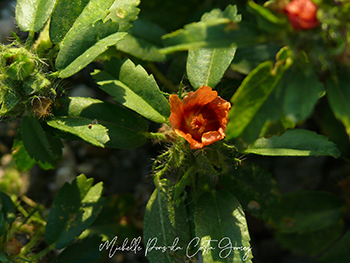This post is also available in: Dutch (below)
Take a good look at any random verge with ‘weeds’ in the city centre, along a junction or the side of the road and there is a good chance that you will see a small ‘creeping’ plant with small, but nevertheless striking bright orange flowers with a dark red heart of about 1 centimetre in diameter. This is the Yerba di pinda also called Bracted fanpetals in English.
In taxonomy, the science that classifies and divides species according to relationship, there is always discussion about where a species belongs or not. And that is also the case with the plant species with the genus name Sida. These plants are still together in a family group called Malvaceae, which also includes the Cotton plant and the Basora kòrá. But in practice, scientists absolutely do not agree on where this plant actually belongs. And there are also various plants that are considered to be Sida-like but that have never been described.

Yerba di pinda is a native plant to the islands and its flowers are frequently visited by butterflies, bees, wasps and also ants.
English name: Bracted fanpetals
Papiamentu/Papiamento name: Yerba di pinda
Scientific name: Sida ciliaris
Family: Malvaceae (mallows family))
Occurrence (ABC islands): Aruba, Bonaire and Curaçao
Publications used:
- Proosdij, A.S.J. van 2012. Arnoldo’s Zakflora: Wat in het wild groeit en bloeit op Aruba, Bonaire en Curaçao. 318 pp. Walburg Pers, Zutphen.
- Plants of the world online
- Dutch Caribbean Species Register
- Wikipedia
Wilde bloemen: Sida ciliaris
Kijk eens een goed in een willekeurige berm met ‘onkruid’ in de binnenstad, langs een kruispunt of in een berm en de kans is groot dat je een kruipend plantje ziet met kleine, maar toch opvallende feloranje bloemetjes met een donkerrood hart van ongeveer 1 centimeter in doorsnede. Dit is de Yerba di pinda.
In de taxonomie, de wetenschap die soort classificeert en indeelt naar verwantschap is altijd discussie over waar een soort thuishoort of juist niet. En dat is ook het geval met de plantensoorten met de genus naam Sida. Nog steeds staan deze planten samen in een familiegroep met de naam Malvaceae, waar ook de Katoenplant en de Basora kòrá in zitten. Maar in de praktijk zijn wetenschappers er absoluut niet over eens waar deze plant nou eigenlijk bij hoort. En er zijn ook verschillende planten die wel als een Sida-achtige worden gezien maar die nog nooit zijn beschreven.

Yerba di pinda is een inheemse plant van het eiland en de bloemen worden vaak bezocht door vlinders, bijen, wespen en ook mieren.
Nederlandse naam: –
Papiamentse naam: Yerba di pinda
Wetenschappelijke naam: Sida ciliaris
Familie: Malvaceae (Kaasjeskruidfamilie )
Voorkomen (ABC eilanden): Aruba, Bonaire en Curaçao
Gebruikte publicaties:
- Proosdij, A.S.J. van 2012. Arnoldo’s Zakflora: Wat in het wild groeit en bloeit op Aruba, Bonaire en Curaçao. 318 pp. Walburg Pers, Zutphen.
- Plants of the world online
- Dutch Caribbean Species Register
- Wikipedia
- Oxford University Plants 400: Indigofera tinctoria